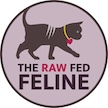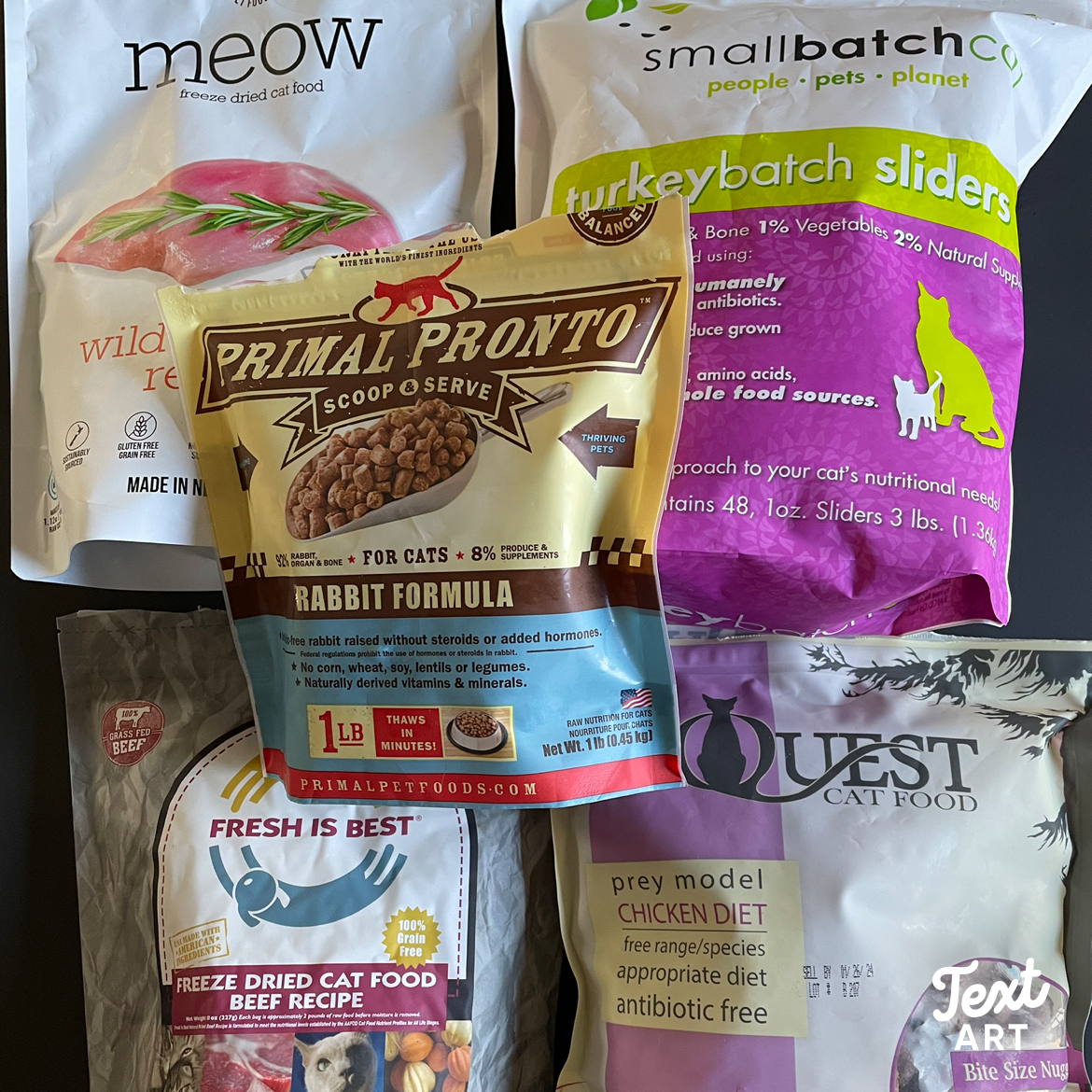Let’s take a closer look at commercial freeze dried and frozen raw foods. I briefly mentioned these as two viable ways to feed your cat a raw food diet here. However, discussing these options in more detail is important as they are often how people first get started feeding raw. I often refer to freeze dried raw foods as my “gateway food” to raw feeding!
Commercial freeze dried foods
Freeze dried foods are a really good option to start with as they do not have the same “ick” factor that many people associate with raw feeding. I think that freeze dried raw is particularly nice for people who do not eat meat themselves. The food is very dry, has no odor, and does not even really look like meat. They come in different shapes, depending on the brand. They most often look like small bricks, squares, or pellets. Measure out how much you need to feed your cat, then add warm (not hot) water, and mix together. You can add as much water as needed to rehydrate it. If your cat prefers a “soupier” consistency, you can add extra water. It can end up looking something like a mush or soup.
Rehydrate, please
All freeze dried foods have undergone a process of extreme freezing that removes the moisture. This process results in a very dry, shelf stable food that retains its nutrients. One of the most important things to remember when feeding freeze dried foods is that they absolutely MUST be fed properly rehydrated—even if the bag says you can feed it dry.
Freeze dried foods have even less moisture than dry kibble! You can read more about the importance of moisture in a feline diet here. Dry kibble has 10-12% moisture. Freeze dried foods, before being rehydrated, have only 5-8% moisture. If fed dry, they will cause dehydration and possibly constipation. One thing to note is that many freeze dried rabbit foods are particularly prone to causing constipation due to their higher bone content. This is where feeding a variety in rotation is important to help provide overall balance in the diet.
Some popular freeze dried foods available in North America include (in no particular order): Primal, Fresh is Best, Northwest Naturals, Meow, Stella & Chewy, and Steve’s. These brands offer a range of protein options and can be found online and at many local pet stores. Freeze dried foods are very convenient. They are shelf stable, so they are a nice option when you don’t have lots of freezer space. I keep some freeze dried food in Hazel’s rotation, so that they remain familiar to her in case of a power outage or for traveling.

Commercial frozen raw foods
Frozen commercial raw foods are another very easy to start with option. They also have a lower “ick” factor as they require no real handling on your part, have minimal smell, and don’t really look like meat. They can come in several shapes as well: sliders, which look like small hockey pucks, pellets, bricks, and in tub shaped containers that resemble canned food. Measure out how much you need for the next day and thaw in a container in the refrigerator overnight. Then you literally just scoop into your cat’s dish and serve.
Frozen raw foods can be found in the freezer section of many pet stores as well as online. Some brands even offer a home delivery service. Popular brands available in North America include: Small Batch, Steve’s Quest, Primal, Northwest Naturals, Bobcat Raw, Wildcoast Raw, and Lotus. Most commercial raw foods are made with bone, but Bobcat Raw, Wildcoast Raw, and Lotus have boneless options available, too. Boneless raw foods can be nice for senior cats or cats with kidney issues.
Ratio vs complete frozen foods
The brands of frozen raw food that I mentioned above are complete foods. You want to pay attention if the frozen raw food is a ratio base for making your own food or is already nutritionally complete. Base foods only include meat, bone, and organ. They do not include additional supplements to make it complete. Here is an example of the ingredient list of a base food from My Pet Carnivore: Ground beef, beef bones, beef heart, beef liver, beef kidneys, beef lung. As you can see, there are no other vitamins or minerals included.
Here’s what an ingredient list looks like from a complete food from Bobcat Raw: Chicken thigh meat, chicken liver, chicken hearts, filtered water, egg yolk powder, egg shell powder, taurine, iodized salt, vitamin E, iron amino acid chelate, copper citrate, manganese amino acid chelate, zinc oxide, vitamin D3, vitamin B12, vitamin B1.
You can also look for the regulatory bodies’ statement on many commercial foods (AAFCO or FEDIAF). In the US, the AAFCO statement on a complete raw food looks like this: “COMPLETE AND BALANCED- CHICKENBATCH CAT IS FORMULATED TO MEET THE NUTRITIONAL LEVELS ESTABLISHED BY THE AAFCO CAT FOOD NUTRIENT PROFILES FOR ALL LIFE STAGES.” This statement is from the complete chicken frozen raw food from Small Batch.
Frozen raw foods are an easy and really convenient way to feed a raw diet. They do not require a lot of work in terms of preparation or any calculation of nutrients. They are as simple as feeding canned food with the exception of needing to thaw prior to serving. There are lots of brands and proteins to choose from, so you can provide a wide variety. You need to have some freezer space available and they cost more than if you make the food yourself.

Give commercial raw food a try
Commercial raw foods are a fantastic way to dip your toes into raw feeding. Check out the FaceBook group Feline Nutrition-Feed Cats Like Cats for more detailed lists and nutrient breakdowns of freeze dried and frozen commercial raw foods.
If introducing some raw food to your feline is one of your goals, freeze dried and/or frozen raw foods are an excellent place to start! Keep in mind that you don’t have to make an abrupt shift to feeding a complete raw food diet. You can gradually introduce some raw foods to your cat, then maybe feed one meal a day as raw, and eventually a full raw diet. Baby steps can be important for not only your cat, but for you, too!


